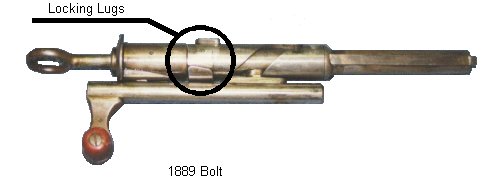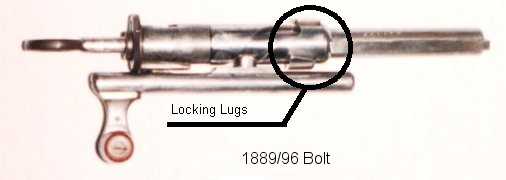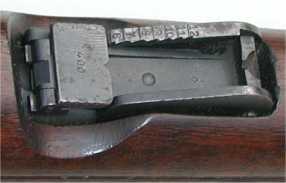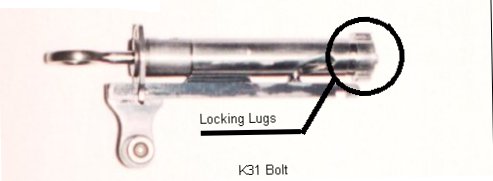|||On December 20, 1866 the Swiss committed themselves to adopting a repeating rifle to arm their armed forces. At the time no suitable design existed. The task of designing the rifle was left to designer Friedrich Vetterli, who had joined the Schweizerische Industrie-Gesellschaft Waffen-Department (SIG) in 1864. Vetterli already been involved in weapon design with the Germans, French, and British, and was strongly influenced by American rifle designs, most notably the Henry Repeating rifle. By 1866, Vetterli had already come up with a single shot, bolt operated rifle. The action was a modified Terry action, designed in England in the early 1850s. 1867 saw the wedding of the bolt action concept to the tube magazine, and 1868 resulted in a spring operated bolt. On February 27, 1868 the Swiss government placed an order for 80,000 Vetterli rifles.

A brass mock-up of a Vetterli RifleThis design represented a significant advance in European Military Technology. Up to this point, the Swiss had been using Milbank-Amsler Rifles, single-shot muzzleloaders, which had been converted to fire rimfire cartridges (for more information about Milbank-Amsler rifles, click here and here.) The Vetterli Rifles were capable of holding up to 13 rounds, and a rate of fire of 21 rounds per minute.
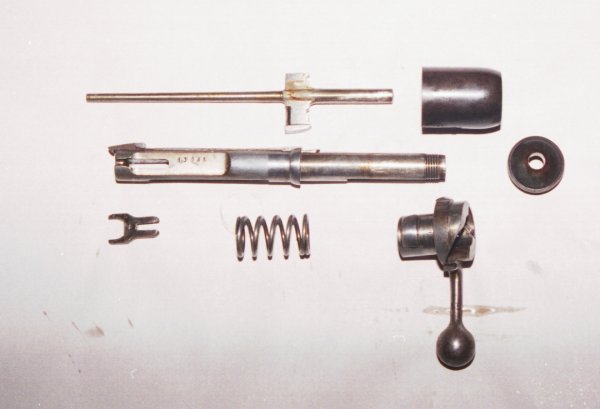
Vetterli Bolt
This amount of firepower significantly outstripped that of any rifle in regular Military Service of the day. The Vetterli was chambered to fire the 10.4x38 Rimfire round. Although a rimfire round, it shot further and flatter than most of it’s contemporaries. The Vetterli striker has a forked firing pin which passes through two firing pins holes in the bolt face for a double strike on the rimfire cartridge, improving the likelihood of ignition.
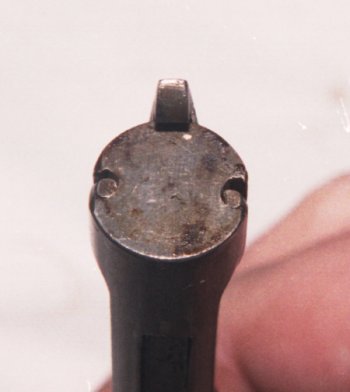
Vetterli bolt face - Note the dual strikers
The Model 1867 Vetterli

Barrel Length: 33.5 inches
Overall Length: 52.0 inches
Weight: 10.38 lbs empty
Chambering: 10.4x38 (.41) Swiss Rimfire
Rifling: 4 groove, RH twist, 1 in 31.9"
Velocity: 1425 fps
Capacity: 13 (12 round tubular magazine +1 in the cartridge elevator)
The Model 1867 was Vetterlis first repeating rifle design. It combined a bolt action with an under-barrel cartridge magazine. The under-barrel magazine tube, although inspired by the Henry rifle, different in function. Vetterli’s design loaded the cartridge from the receiver, whereas the Henry design was loaded from the muzzle end of the tube.
While the bolt was used to load and eject cartridges, the rifle used an external hammer. When the trigger was pulled, the hammer dropped, impacting the striker rod, free floating in the bolt, which then forces the forked firing ping to impact the rim of and ignited the cartridge.
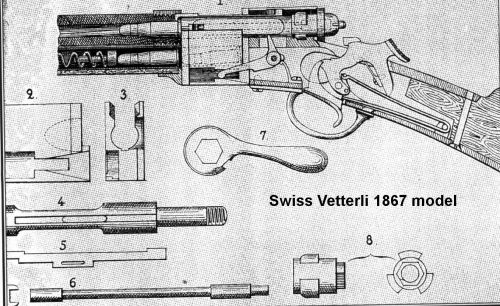
Image courtesy of MilitaryRifles.com
The Model 1868 Vetterli

Barrel Length: 33.2inches
Overall Length: 52.0 inches
Weight: 10.26 lbs empty
Chambering: 10.4x38 (.41) Swiss Rimfire
Rifling: 4 groove, RH twist, 1 in 26"
Velocity: 1425 fps
Capacity: 13 (12 round tubular magazine +1 in the cartridge elevator)
On February 27,1868 the Model 1867 Vetterli was accepted for service by the Swiss Federal Council. However, before the 1867 could go into production, Friedrich Vetterli, improved the design by replacing the external hammer with a spring cocking bolt. The new design was designated as the Model 1868. The initial Model 1868’s were manufactured with their cleaning rods mounted on the left side of the stock. However, it was soon discovered that the rods were prone to damage. Consequently, in August of 1868 the design was modified, and the cleaning rod was moved to below the barrel. And the new rifle was designated the Model 1869.
The 1868’s side mounted cleaning rod
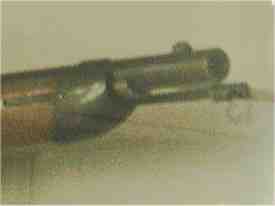
The Model 1869 Vetterli

Barrel Length: 33.1inches
Overall Length: 51.2 inches
Weight: 10.16 lbs empty
Chambering: 10.4x38 (.41) Swiss Rimfire
Rifling: 4 groove, RH twist, 1 in 26"
Velocity: 1425 fps
Capacity: 12 (11 round tubular magazine +1 in the cartridge elevator)
Total Production: 150,000
Manufacture Dates: 1869-1874 SIG, Neuhausen (total 59,000)
1869-1875 Eidgenössische Montier-Werstätte, Bern (total 8900)
1875-1879 Eidgenössische Waffenfabrik, Bern (total 36,000)
1869-1873 Cordier & Cie, Bellefontaine (total 4000)
1869-1874 W. von Steiger, Thun (total 15,200)
1869-1874 Ost-Schweizerische Büchsenmacher, St. Gallen
(total 8700)
1869-1873 Rychner & Keller, Aarau (total 9700)
1869-1873 Valentin Sauerbrey, Basel (total 7000)
1869-1874 Zürich Zeughaus (total 1500)
Detailed Production Information
The loading gate on a 1869
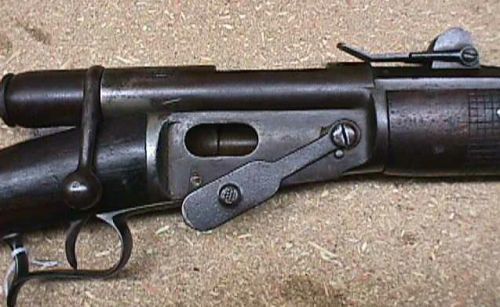
Image courtesy of MilitaryRifles.com
The Model 1869 Vetterli was the first model Vetterli to go into full scale production. In addition to the moving of the cleaning rod, there were several other differences between the Model 1868 and Model 1869. Notably, the tube magazine was shortened by one round. In addition, a knurled ring was added to the cocking piece, and a pair gas-escapes hole were added above the chamber. The rifle was also slightly shortened and lightened.
The loading mechanism of a Model 1869
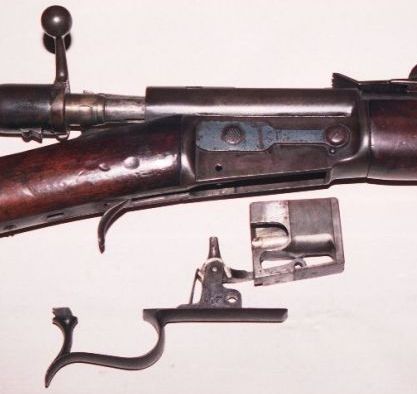
Repeating Carbine built between 1869-1871
Barrel Length: 19.1 inches
Overall Length: 37.2 inches
Weight: 8.6 lbs empty
Chambering: 10.4x38 (.41) Swiss Rimfire
Rifling: 4 groove, RH twist, 1 in 26"
Velocity: 1230 fps
Capacity: 7 ( 6 round tube magazine +1 in the cartridge elevator)
Total Production: ???
Manufacture Dates: As per the original rifle. The conversion dates are unknown.
These carbines were produced by cutting down M1869/71 Rifles. A rifle-style nosecap was fitted with the front sight. There was no provision for a bayonet. While it is believed this weapon was intended for use by the Border Guards, there are no records of this carbine ever being issued. These rifles are often mistakenly marketed as Model 1878 Border Guard Carbines. However, Model 1878 was fitted with carbine style rear sights, and had barrel mounted front sights.
A number of fake carbines exists, and are being marketed as real. Fake carbine tend to have barrel mounted front sights, smaller rear sights , and may either be missing the middle band, or have two barrel bands spaced close together.
Model 1870 Police Carbine

Barrel Length: 29 inches
Overall Length: 45 inches
Weight: 8.95 lbs empty
Chambering: 10.4x38 (.41) Swiss Rimfire
Rifling: 4 groove, RH twist, 1 in 26"
Velocity: 1410 fps
Capacity: 8 (7 round tube magazine +1 in the cartridge elevator)
Total Production: ???
Manufacture Dates: around 1870
This particular model was intended for police use. It’s length and weight were between that of the rifle and carbine. However, while SIGs records suggest some of these model were sold to police forces, there are no records of any Swiss Police forces actually using this model. Police Carbines appear to have been based on both 1869 and 1878 models. Those which were based on 1878s had the sling swivel mounted on the muzzle band rather, rather than the barrel band as pictured above.
The Model 1870 Cadet Rifle

Image courtesy of Mike Boynton
Barrel Length: 26.75 inches
Overall Length: 45.25 inches
Weight: 7.16 lbs empty
Chambering: 10.4x38 (.41) Swiss Rimfire
Rifling: 4 groove, RH twist, 1 in 26"
Velocity: ~1300 fps
Capacity: Single Shot
Total Production: ???
Manufacture Dates: 1870-1873 SIG, Neuhausen
This single shot cadet rifle was manufactured in limited number by SIG. It had a one piece wood stock, and no provision for a bayonet. In order to accommodate the smaller stature of the cadet, a reduced load round was produced which used 3grams vs. 3.65grams of blackpowder, thus reducing recoil.
The Model 1869/71 Vetterli

Barrel Length: 33.1inches
Overall Length: 51.2 inches
Weight: 10.4 lbs empty
Chambering: 10.4x38 (.41) Swiss Rimfire
Rifling: 4 groove, RH twist, 1 in 26"
Velocity: 1425 fps
Capacity: 12 (11 round tubular magazine +1 in the chamber)
In 1871 the Model 1869 was updated with an improved elevator system and simplified receiver. The loading gate was omitted as was the magazine cut-off, which had previously appeared on the left side of the receiver.
The right side of a 1869/71 Receiver
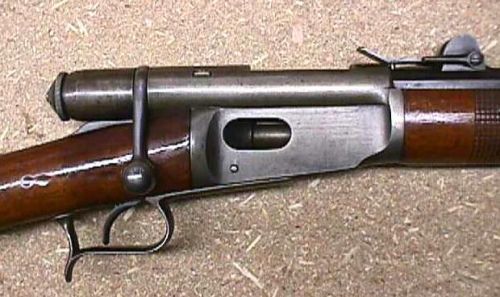
Image courtesy of MilitaryRifles.com
Comparison of the 1869 & 1869/71 Left Receivers
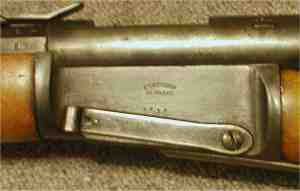
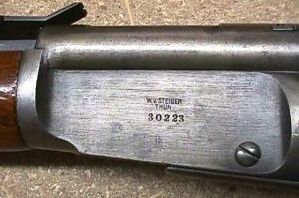
Images courtesy of MilitaryRifles.com
Internally, the loading mechanism was also modified.
A Model 1869/71 loading mechanism
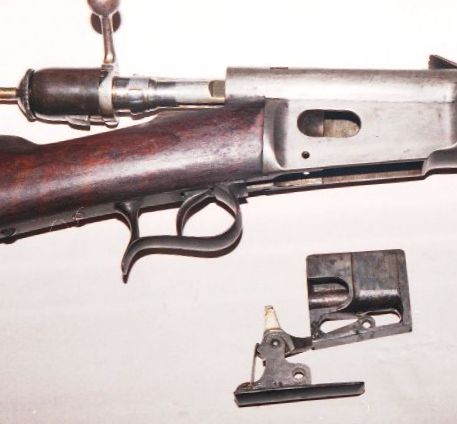
Over the course of it’s production life, several other modifications were made to the Model 1869/71. The modifications include tighter barrel tolerances, the omission of the ejection port cover, improvements of the front and rear sights, and the omission of the gas escape holes above the chamber.
A Vetterli receiver with an ejection port cover
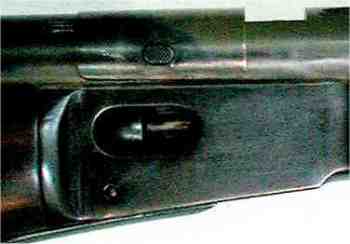
Model 1871 Carbine

Image scanned from Die Repetiergewehre Der Schweiz
Barrel Length: 18.5 inches
Overall Length: 36.7 inches
Weight: 7.16 lbs empty
Chambering: 10.4x38 (.41) Swiss Rimfire
Rifling: 4 groove, RH twist, 1 in 21.7"
Velocity: 1230fps
Capacity:7 (6 round tube magazine +1 in the cartridge elevator)
Total Production: 3000
Manufacture Dates: 1871-1872 Eidgenössische Montier-Werstätte, Bern (total ~500)
1872-1874 Rudolf Pfenninger, Stäffe (total 2500)
Detailed Production Information
Adopted on February 9, 1871, this carbine had a rotating ejector cover, straight-edged fore end, and a spatula style bolt handle. Originally the carbine was fitted with a folding leaf sight, but this was soon replaced with a tangent sight. At the same time, the bolt handle and fore end were reshaped. Later, in 1874 a Schmidt-pattern rear sight was adopted, and as rifle were sent in for repairs, the sights were replaced.
Model 1871 Carbine Variant 2

Model 1871 Stutzer

Barrel Length: 30.9 inches
Overall Length: 49.6 inches
Weight: 10.2 lbs empty
Chambering: 10.4x38 (.41) Swiss Rimfire
Rifling: 4 groove, RH twist, 1 in 26"
Velocity: 1375 fps
Capacity: 11 (10 round tube magazine +1 in the cartridge elevator)
Total Production: 16,000
Manufacture Dates: 1871-1874 SIG, Neuhausen (total 1000)
1869-1875 Eidgenössische Montier-Werstätte and Eidgenössische
Waffenfabrik, Bern (total 15,000)
Detailed Production Information
The 1871 Stutzer incorporated several modifications over the 1869/71 and was intended for riflemen. The 1871 included double-set triggers and special heavy buttplates. The rifles were shorter, and had a single barrel band. Early Stutzer models used the Thury dual trigger set, however, after 1875 a dual trigger set designed by Rudolph Schmidt was adopted. However, while the Stutzer possessed a shorter barrel, it kept the Model 1869s rear sights. This produced a point of impact error at when using the rear sights range graduations.
Model 1878 Rifle

Barrel Length: 33.1 inches
Overall Length: 52.2 inches
Weight: 10.1 lbs empty
Chambering: 10.4x38 (.41) Swiss Rimfire
Rifling: 4 groove, RH twist, 1 in 26"
Velocity: 1425 fps
Capacity: 13 (12 round tube magazine +1 in the cartridge elevator)
Total Production: 15,770
Manufacture Dates: 1878-1881 Eidgenössische Waffenfabrik, Bern
Detailed Production Information
Although attempts had been made to improve the 69/71 design, the Model 1878 action, aside from some minor improvements, changed very little. Externally, the 1878 had only one barrel band and lacked the stock-dicing of the earlier models. Other changes included the omission of the gas relief holes, the adoption of a curved buttplate, and changes were made to the metal finishing process. In addition, the 1878 front barrel band was fitted with a bayonet lug to allow it to mount a sword bayonet, rather than a socket bayonet. The older style sights were replaced with Schmidt Quadrant Sight Note: many of rifles which are marked M.78, are actually Model 1878/81s. See below.
Model 1878 Stutzer

Barrel Length: 32.8 inches
Overall Length: 52.2 inches
Weight: 10.1 lbs empty
Chambering: 10.4x38 (.41) Swiss Rimfire
Rifling: 4 groove, RH twist, 1 in 26"
Velocity: 1425 fps
Capacity: 13 (12 round tube magazine +1 in the cartridge elevator)
Total Production: 400
Manufacture Dates: 1878-1881 Eidgenössische Waffenfabrik, Bern
Detailed Production Information
A limited number (400) of a Stutzer version of the Model 1878 was produced. The Model 1878 Stutzer continued to use the Schmidt dual-set triggers which were introduced in the 1871 Stutzer line. It is uncertain as to whether or not the Model 1878 Stutzer was ever actually issued. It also appears that most if not all 1878s, had their rear sights replaced with 1881 pattern sights.
Model 1878 Carbine

Image posted with permission
Barrel Length: 18.5 inches
Overall Length: 36.55 inches
Weight: 7.26 lbs empty
Chambering: 10.4x38 (.41) Swiss Rimfire
Rifling: 4 groove, RH twist, 1 in 21.7"
Velocity: 1230 fps
Capacity: 7 ( 6 round tube magazine +1 in the cartridge elevator)
Total Production: 1720
Manufacture Dates: 1879-1885 Eidgenössische Waffenfabrik, Bern
Detailed Production Information
Adopted in 1878 for the dragoons, this carbine, while sharing the same action as the rifle, was greatly shortened. While the Model 1878 Carbine incorporated many of the same improvements the Model 1878 Rifle received, the pivoting loading-gate was retained. There were no provisions for mounting a bayonet.
Model 1878 Border-Guard Carbine

Barrel Length: 19.1 inches
Overall Length: 37.2 inches
Weight: 7.36 lbs empty
Chambering: 10.4x38 (.41) Swiss Rimfire
Rifling: 4 groove, RH twist, 1 in 21.7"
Velocity: 1230 fps
Capacity: 6 (5 round tube magazine +1 in the cartridge elevator)
Total Production: 400
Manufacture Dates: 1880-1881 Eidgenössische Waffenfabrik, Bern
These carbines are essentially shortened M.1878 Rifles with carbine style sights fitted. However, these rifles were not conversions, they were purpose built. Examples of this carbine can be found both with and without the pivoting loading gate . Note: the front barrel band was fitted with a bayonet lug. As the name suggests, this carbine was issued to the Border Guards.
Models 1878/81 and 1881 Rifles

Barrel Length: 33.5 inches
Overall Length: 52 inches
Weight: 10.19 lbs empty
Chambering: 10.4x38 (.41) Swiss Rimfire
Rifling: 4 groove, RH twist, 1 in 26"
Velocity: 1425 fps
Capacity: 13 (12 round tube magazine +1 in the cartridge elevator)
Total Production: 37,010 Model 1878/81s 25,3000 Model 1881s
Manufacture Dates: 1882-1889 Eidgenössische Waffenfabrik, Bern
Detailed Production Information
This model was equipped with an improved rear sight. Also, various steel components replaced iron components, and the 1881 continued to see improvements in metal finishing. Otherwise, it was largely identical to the 1878 Rifle. Curiously enough, even after the updates were made, the Swiss continued to mark these rifles with the M.78 stamp on the left side of the receiver. It wasn’t until around 1887, that the the M.81 mark replaced the M.78 stamp. M.78 marked rifles are referred to as Model 1878/81 Rifles.
Model 1878 Sight Model 1881 Sight
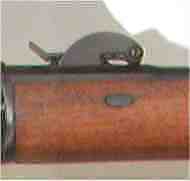
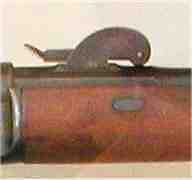
Model 1881 Stutzer

Barrel Length: 33.5 inches
Overall Length: 52 inches
Weight: 10.19 lbs empty
Chambering: 10.4x38 (.41) Swiss Rimfire
Rifling: 4 groove, RH twist, 1 in 26"
Velocity: 1425 fps
Capacity: 13 (12 round tube magazine +1 in the cartridge elevator)
Total Production: 7538
Manufacture Dates: 1882-1889 Eidgenössische Waffenfabrik, Bern
Detailed Production Information
The Model 1881 Stutzer, like it’s predecessors, was intended for sharpshooters. While externally very similar to the Model 1881 Rifle, the internals are quite different. The 1881 used an improved Schmidt dual trigger system.
The Model 1881 Stutzer’s Trigger unit
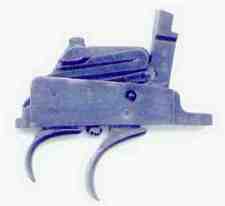
The entire trigger unit is held in by a single screw. When the screw is removed, the unit drops free of the receiver. As with most double trigger designs, the rear trigger is the set trigger. When pulled back, it set the forward trigger to release with almost no effort.
Afterword
While the Swiss never used the Vetterli in any armed conflict, it is interesting to note the closest they ever came to combat was in Finland. According to Markku Palokangas, author of the book Military Small Arms in Finland 1918-1988:
Finnish supporters of active resistance against Czarist Russian oppression started planning an armed uprising and in 1904 contacted revolutionaries in St. Petersburg. It was agreed that weapons would be acquired in Central Europe and were to be smuggled partly to the St. Petersburg area, partly to Finland.
Colonel Akashi, Japanese Military Attaché in Stockholm, became financier of the operation. In this way Japan intended to cause confusion in Russia with who she was at war at the time.
With funds received from Col. Akashi the Finn leading the project, Konni Zilliacus, bought from Paris and Hamburg over 15,000 Vetterli rifles {ed. note - they were Model 1869/71s} with ammunition, discarded by the Swiss Army. Also an old cargo vessel, the S/S John Grafton, was acquired for transporting the rifles.
The operation was carried out in August-September 1905. When no one from St. Petersburg arrived at the agreed meeting point at sea the whole cargo was shipped to Finland. Only part of the rifles had been unloaded when the ship ran aground. In fear of being discovered the ship and the remaining cargo were blown up and sunk.
Nevertheless the Russian gendarmes learned of the operation. Rifles from the ship were recovered by divers and those stored ashore were confiscated.
After the unfortunate smuggling effort Vetterli rifles were known in Finland as Graftons, after the sunken ship. During the following years a further small number of Vetterli rifles were acquired and smuggled to Finland.
The Vetterlis featured in the secret preparations for the Finnish uprising but when the War of Independence started in the winter of 1918 the rifles were considered hopelessly outdated and lacked ammunition.
Nevertheless, more Vetterli rifles were obtained during the war when Russian arms depots were captured and rifles confiscated 12 years earlier were found.
The Finnish Defense Forces never adopted the Vetterli rifle as a standard service weapon but there was a small number stored in arms depots until the 1950’s."
The Italians adopted the Vetterli in 1870 as a single shot. A box magazine was later added, and in the early 1900s, many Italian Vetterlis were converted to fire the 6.5 Carcano round. Some of these converted rifles did see service in World War I.
It is significant note that while the rifle was the most advanced of it’s type when adopted, it was likewise the most obsolete when finally replaced. The eventual replacement of the Vetterli, the Schmidt-Rubin series, continued the tradition, of high quality, shooters rifles, started by the Vetterli series.|
| — | — |
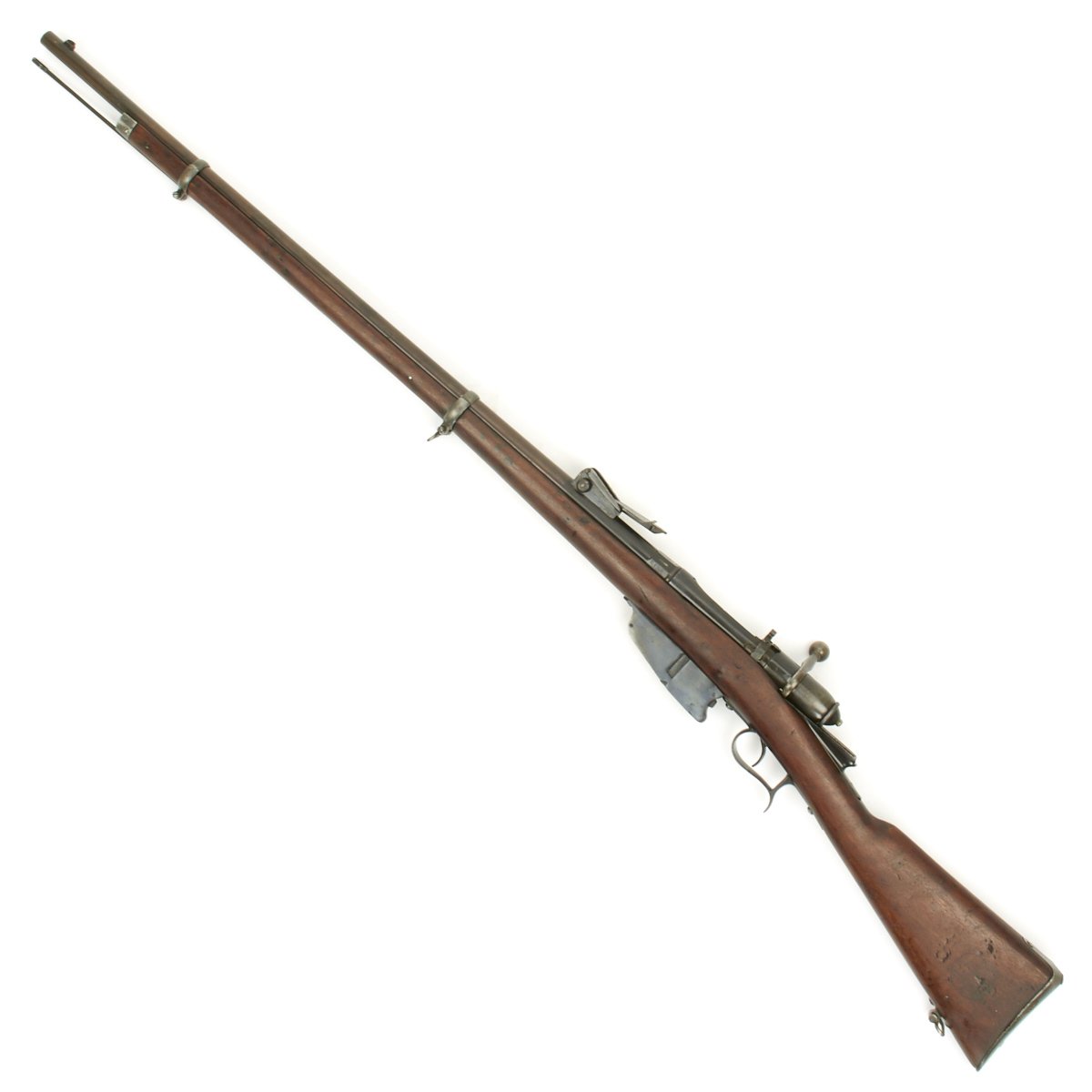

 0000000000000000000000000000000000000000000000000000000000000000
0000000000000000000000000000000000000000000000000000000000000000 

